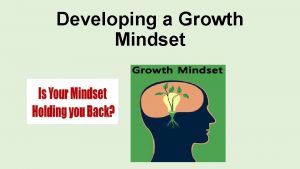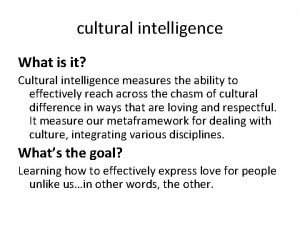CULTURAL INTELLIGENCE IN A VUCA WORLD Lesson 4













- Slides: 13

CULTURAL INTELLIGENCE IN A VUCA WORLD

Lesson 4: Cultural Dimensions LEARNING OBJECTIVE Values are part of human existence and are consistent and stable over time. This concept of cultural dimensions, which are frameworks for how a given group of people in a society behave, are based upon social scientific research that measures a society’s central tendencies. KEY TAKEAWAY • • • Identify three levels of human programming according to intercultural theorist Geert Hofstede and explain their differences. Differentiate each of the 6 Cultural Dimensions based upon Geert Hofstede’s research. Contemplate how the 6 Cultural Dimensions are both verifiable socio-cultural phenomena while at the same time make room for variation among individuals in any given nation. Apply your understanding of Hofstede’s 6 Cultural Dimensions to YOUR national culture in comparison to another national culture. Explore the meanings of: country, nation state, sovereign state, and society. LEADERSHIP APPLICATIONS Since cultures can be measure based upon group tendencies, leaders who know that the principles they follow are backed by strong validity and reliability can engage difference with confidence.

Why is culture so important? PERSPECTIVES FROM Geert Hofstede and son, Gert Jan Hofstede http: //www. geerthofstede. nl/ • Every visitor of this site has her or his unique personality, history, and interest. Yet all people share a common human nature. Our shared human nature is intensely social: we are group animals. We use language and empathy, and practice collaboration and intergroup competition. But the unwritten rules of how we do these things differ from one human group to another. • "Culture" is how we call these unwritten rules about how to be a good member of the group. Culture provides moral standards about how to be an upstanding group member; it defines the group as a "moral circle". It inspires symbols, heroes, rituals, laws, religions, taboos, and all kinds of practices - but its core is hidden in unconscious values that change at a far slower rate than the practices. • We tend to classify groups other than our own as inferior or (rarely) superior. This applies to groups based on national, religious, or ethnic boundaries, but also on occupation or academic discipline, on club membership, adored idol, or dress style. • In our globalized world most of us can belong to many groups at the same time. But to get things done, we still need to cooperate with members of other groups carrying other cultures. Skills in cooperation across cultures are vital for our common survival.

Three Levels of Cultural Programming Specific to individuals Specific to groups Universal Personality Inherited and learned Culture Human Nature http: //www. geerthofstede. com Specific to individuals Biological

Cultural Dimensions Geert Hofstede • Power • Individualism - Collectivism • Gender • Uncertainty • Time Long/Short • Indulgence/Constraint On a scale of 0 -100 http: //geert-hofstede. com/

Cultural Dimensions Power Distance (PDI) Focuses on the degree of equality, or inequality, between people in the country's society. • A High Power Distance ranking indicates that inequalities of power and wealth have been allowed to grow within the society. These societies are more likely to follow a caste system that does not allow significant upward mobility of its citizens. • A Low Power Distance ranking indicates the society de-emphasizes the differences between citizen's power and wealth. In these societies equality and opportunity for everyone is stressed.

Cultural Dimensions Individualism (IDV) Focuses on the degree the society reinforces individual or collective, achievement and interpersonal relationships • A High Individualism ranking indicates that individuality and individual rights are paramount within the society. Individuals in these societies may tend to form a larger number of looser relationships. • A Low Individualism ranking typifies societies of a more collectivist nature with close ties between individuals. These cultures reinforce extended families and collectives where everyone takes responsibility for fellow members of their group.

Cultural Dimensions Masculinity (MAS) Focuses on the degree the society reinforces, or does not reinforce, the traditional masculine work role model of male achievement, control, and power. • A High Masculinity ranking indicates the country experiences a high degree of gender differentiation. In these cultures, males dominate a significant portion of the society and power structure, with females being controlled by male domination. • A Low Masculinity ranking indicates the country has a low level of differentiation and discrimination between genders. In these cultures, females are treated equally to males in all aspects of the society.

Cultural Dimensions Uncertainty Avoidance Index (UAI) Focuses on the level of tolerance for uncertainty and ambiguity within the society - i. e. , unstructured situations • A High Uncertainty Avoidance ranking indicates the country has a low tolerance for uncertainty and ambiguity. This creates a ruleoriented society that institutes laws, rules, regulations, and controls in order to reduce the amount of uncertainty. • A Low Uncertainty Avoidance ranking indicates the country has less concern about ambiguity and uncertainty and has more tolerance for a variety of opinions. This is reflected in a society that is less ruleoriented, more readily accepts change, and takes more and greater risks.

Cultural Dimensions Long-Term Orientation (LTO) Focuses on the degree the society embraces, or does not embrace, longterm devotion to traditional, forward thinking values • A High Long-Term Orientation ranking indicates the country prescribes to the values of long-term commitments and respect for tradition. This is thought to support a strong work ethic where longterm rewards are expected as a result of today's hard work. However, business may take longer to develop in this society, particularly for an "outsider". • A Low Long-Term Orientation ranking indicates the country does not reinforce the concept of long-term, traditional orientation. In this culture, change can occur more rapidly as long-term traditions and commitments do not become impediments to change.

Cultural Dimensions Indulgence and Restraint (I-R) This dimension is defined as the extent to which people try to control their desires and impulses, based on the way they were raised. • A tendency toward a relatively weak control over their impulses is called “indulgence”, • A relatively strong control over their urges is called “restraint”. • Cultures can be described as indulgent or restrained.

Cultural Generalizations Are generalizations considered labels or stereotypes? Milton Bennett, a prominent U. S. scholar in the field of intercultural education: “Good cultural generalizations are based on systematic cross-cultural research. They refer to predominant tendencies among groups of people, so they are not labels for individuals. A given individual may exhibit the predominant group tendency a lot, a little, or not at all. So cultural generalizations must be applied to individuals as tentative hypotheses, always open to verification. ”

Summary All leaders need the proof that what they espouse is credible. This session investigated theory behind cultural dimensions in order to look at how central tendencies of a nation can be used as a starting point in order to understand difference. • Three levels of cultural programming inform our behaviors. The field of intercultural communication has robust scientific evidence to support its claims. • Cultures can be measure based upon group tendencies; however, each individual is different and not all individuals have the same values of a majority group. • Culture is what we call the unwritten rules about how to be a good member of the group. Its core is hidden in unconscious values, which are part of human existence – they are stable and consistent over time; However, values change at a far slower rate than the practices. • All humans share certain things at the deepest level of human nature – e. g. , we all need to eat and sleep; love and be loved; find meaning and happiness in life. It is at the cultural level that we share common experiences that we share with a particular group of fellow human beings and THIS is what informs us regarding what it means to love and be loved; what meaning and fulfillment are, etc. In addition, our personalities add another layer that creates more complexity and creativity with the human condition.
 što znači ekonomično voziti
što znači ekonomično voziti Vuca
Vuca Vuca significado
Vuca significado Diagnosing your cultural intelligence
Diagnosing your cultural intelligence Cultural regions of the world map
Cultural regions of the world map Chinese communist revolution ap world history
Chinese communist revolution ap world history Cultural divergence ap human geography
Cultural divergence ap human geography Malleable intelligence lesson
Malleable intelligence lesson Chapter 8 lesson 4 cultural innovations
Chapter 8 lesson 4 cultural innovations Opposable thumb primates
Opposable thumb primates Coffee new world or old world
Coffee new world or old world Real world vs digital world
Real world vs digital world The world of forms
The world of forms Ap world history chapter 25 africa and the atlantic world
Ap world history chapter 25 africa and the atlantic world
























